Abstract
1. Six normal subjects cycled to endurance or for 60 min at four work rates (WR 1-4): mean of 34% working capacity (93 watts for 60 min); 43% (120 watts for 56 min); 63% (177 watts for 37 min); and 84% (233 watts for 12 min), to determine how breathing pattern and dyspnoea change during prolonged activity. Four to six minutes were allowed to establish steady state and subsequent changes were considered to be endurance related. 2. Dyspnoea (Borg scale, 0-10) increased with the duration of activity at all work rates. 3. Ventilation (VE) did not change at WR1; increased from 44 to 47 l min-1 at WR2; from 60 to 88 l min-1 at WR3; and from 111 to 132 l min-1 at WR4. Dyspnoea was significantly and independently related to ventilation and duration of activity: dyspnoea = 0.004 VE1.36 time 0.25 (r = 0.81; partial F 202 and 26 respectively). 4. Inspiratory resistance did not increase at any work rate. Dynamic elastance remained constant during WR1, WR2 and WR3 but increased from 7.4 to 9.1 cmH2O l-1 during WR4. 5. Peak inspiratory pressure did not increase, and the increase in VE was accomplished by an increased breathing frequency without change in duty cycle. 6. Duration of activity is an important contributor to dyspnoea independent of changes in respiratory muscle contractile activity.
Full text
PDF


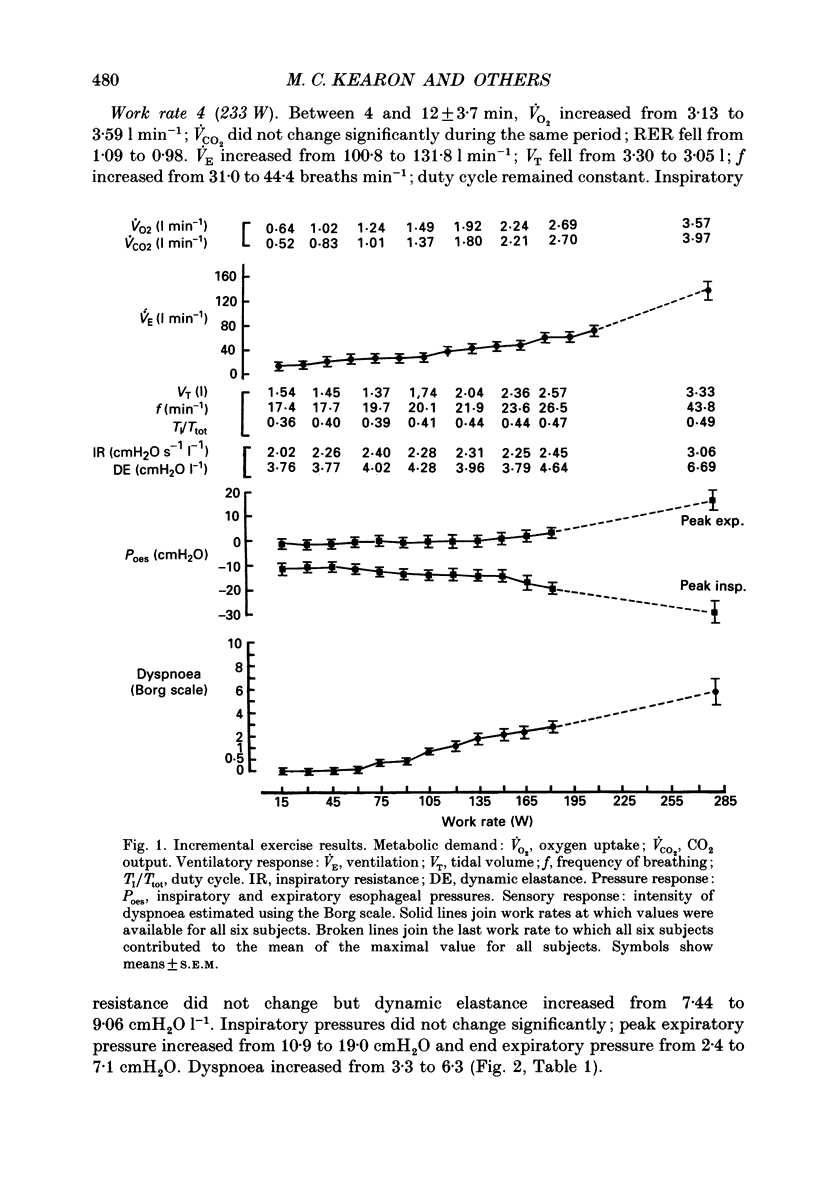
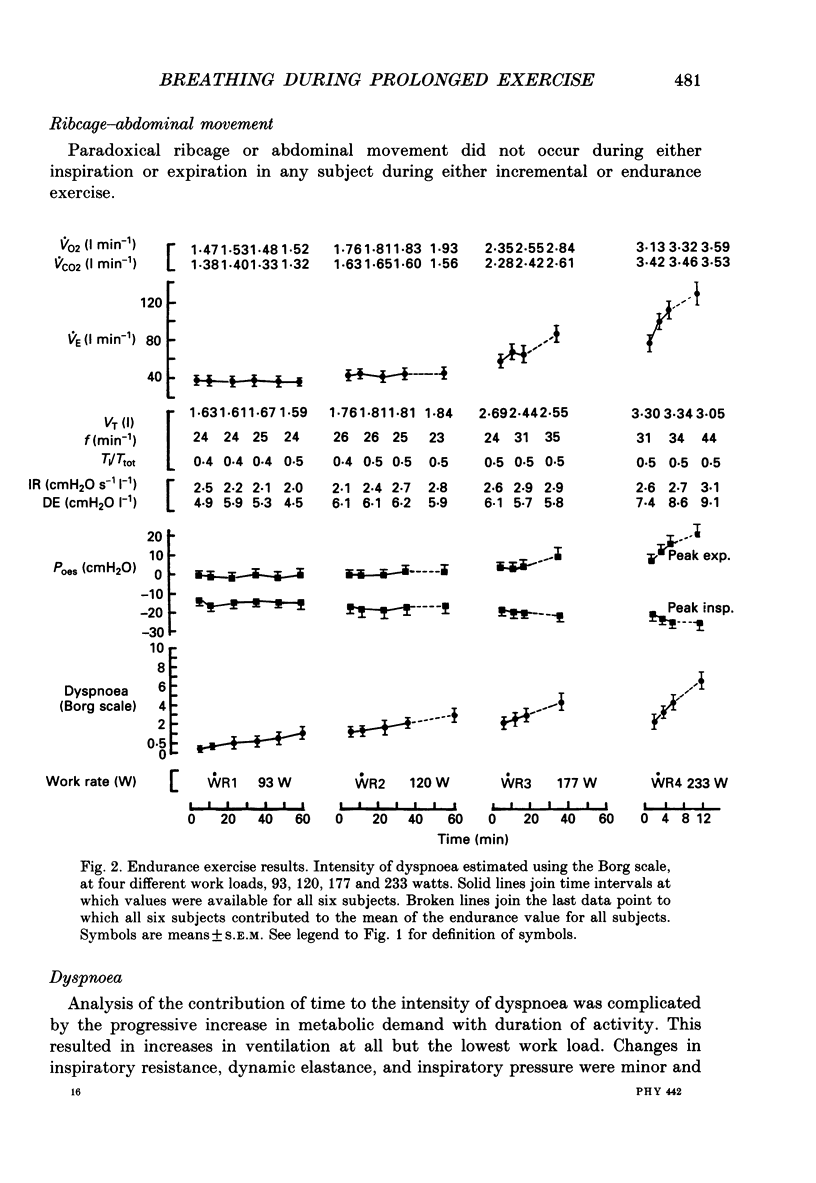
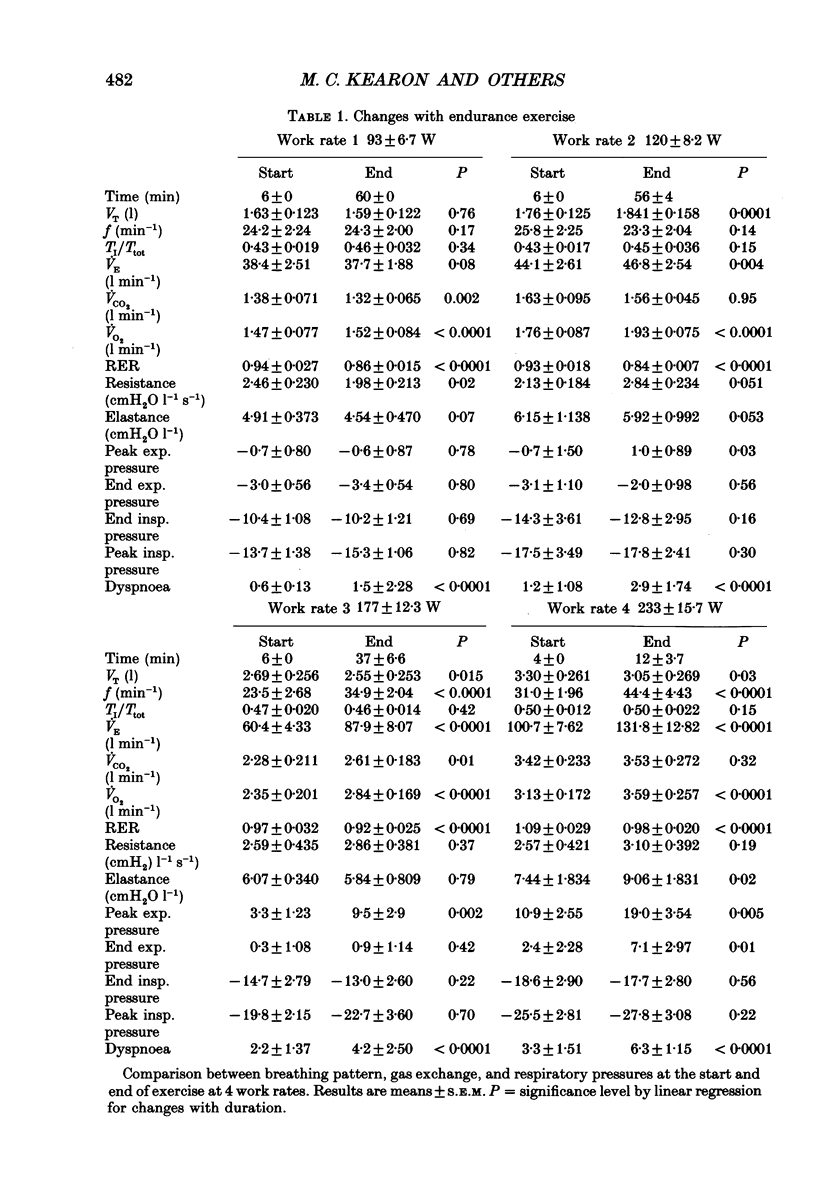
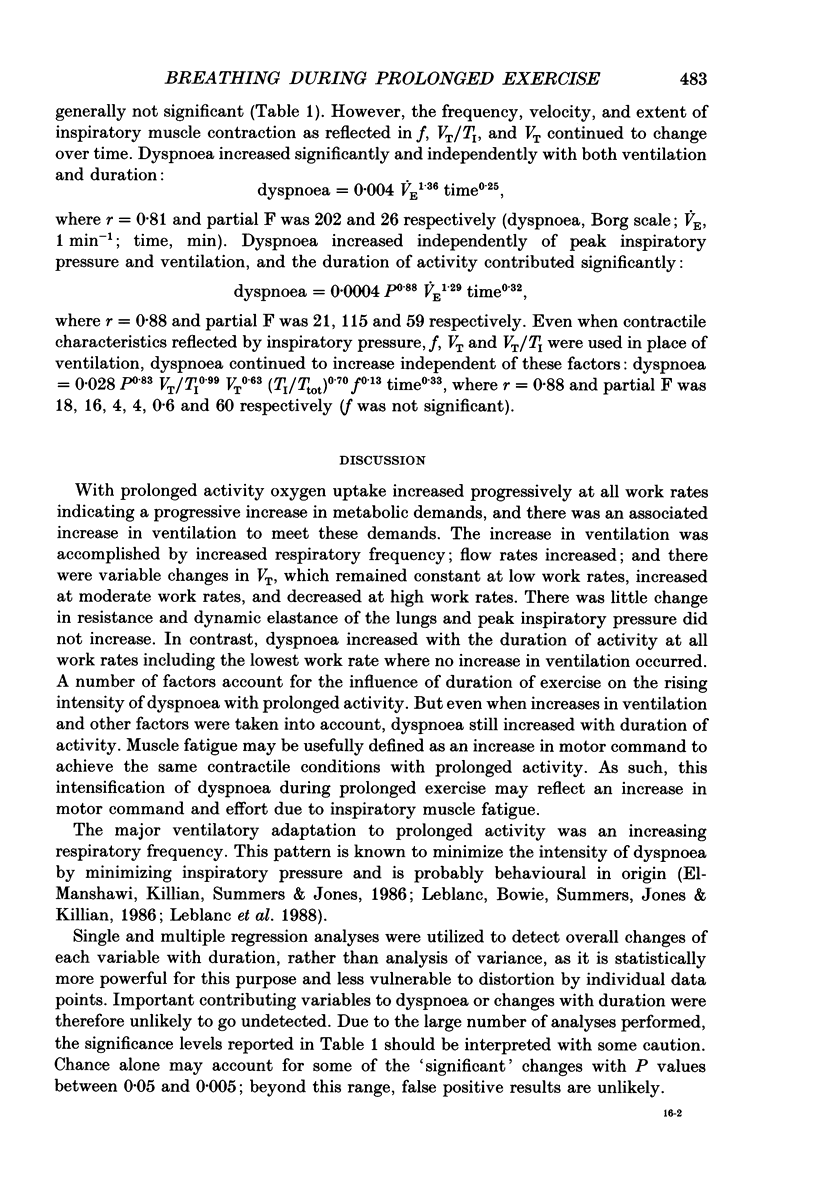

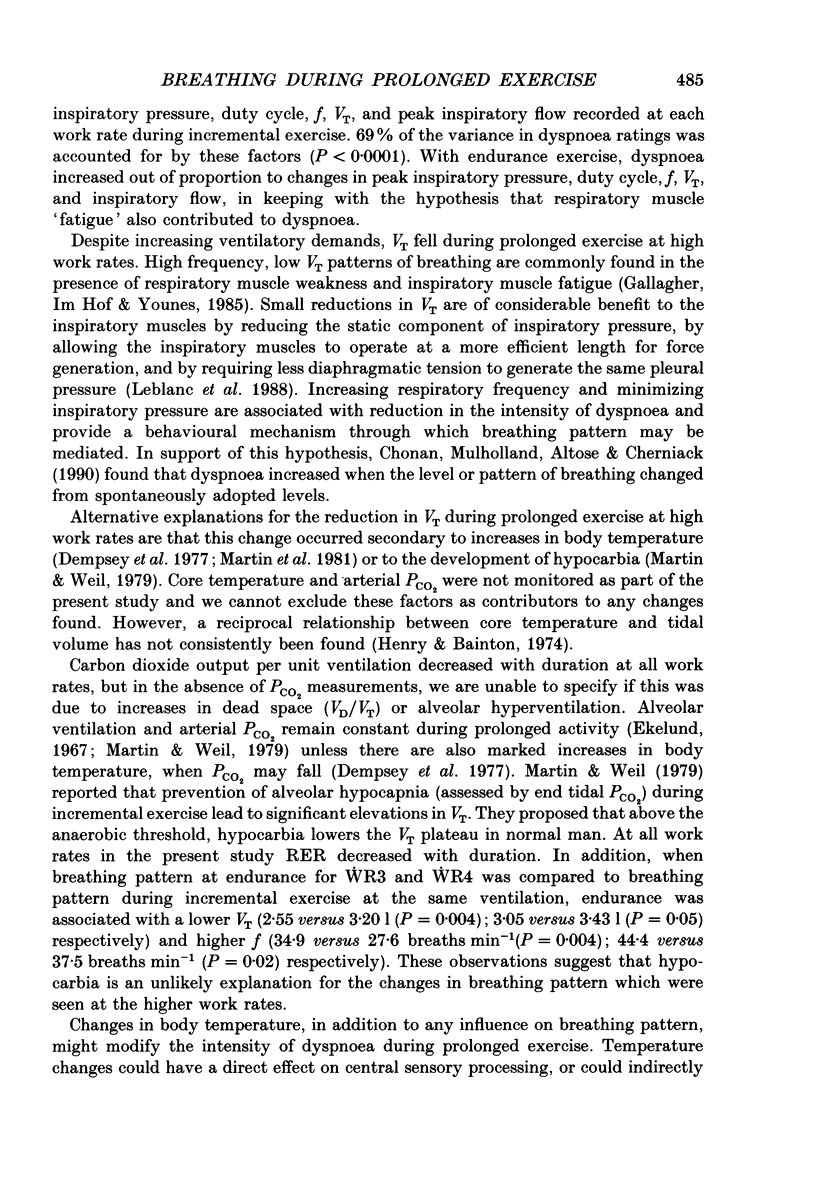
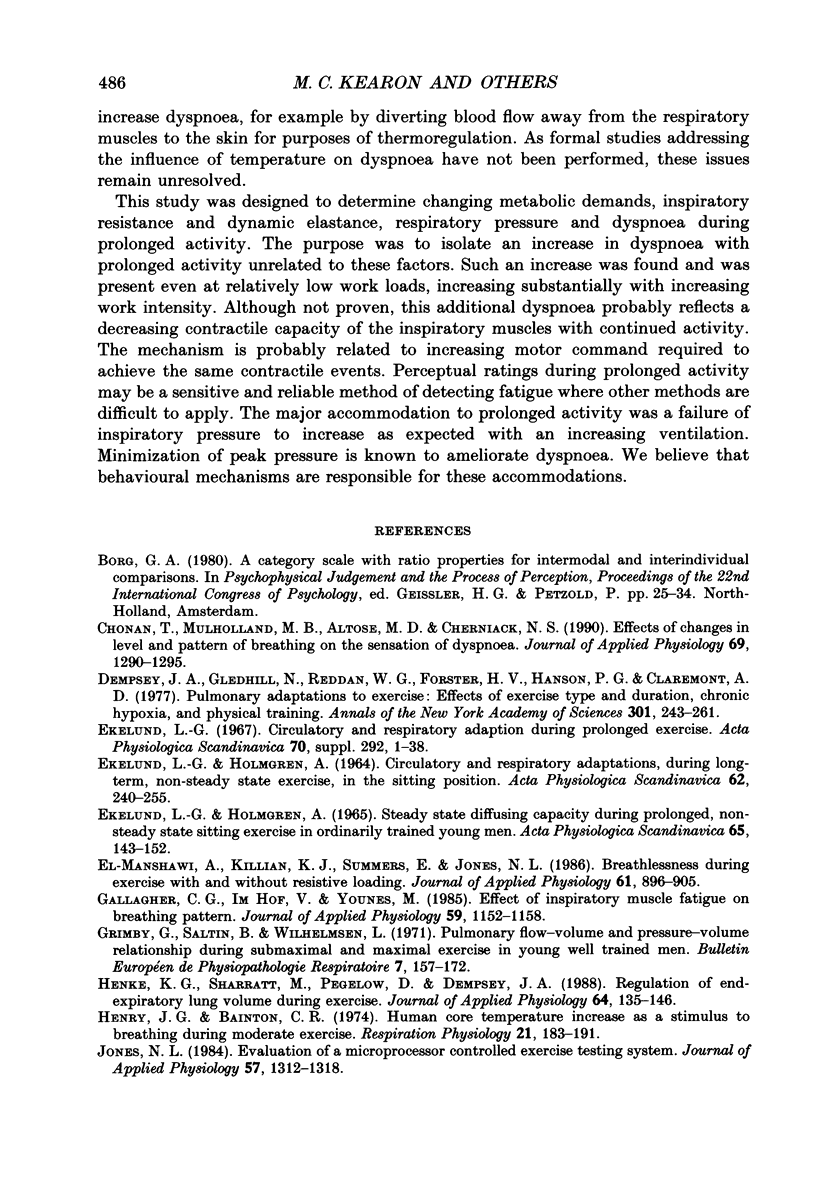

Selected References
These references are in PubMed. This may not be the complete list of references from this article.
- Chonan T., Mulholland M. B., Altose M. D., Cherniack N. S. Effects of changes in level and pattern of breathing on the sensation of dyspnea. J Appl Physiol (1985) 1990 Oct;69(4):1290–1295. doi: 10.1152/jappl.1990.69.4.1290. [DOI] [PubMed] [Google Scholar]
- Dempsey J. A., Gledhill N., Reddan W. G., Forster H. V., Hanson P. G., Claremont A. D. Pulmonary adaptation to exercise: effects of exercise type and duration, chronic hypoxia and physical training. Ann N Y Acad Sci. 1977;301:243–261. doi: 10.1111/j.1749-6632.1977.tb38203.x. [DOI] [PubMed] [Google Scholar]
- EKELUNG L. G., HOLMGREN A. CIRCULATORY AND RESPIRATORY ADAPTATION, DURING LONG-TERM, NON-STEADY STATE EXERCISE, IN THE SITTING POSITION. Acta Physiol Scand. 1964 Nov;62:240–255. doi: 10.1111/j.1748-1716.1964.tb03971.x. [DOI] [PubMed] [Google Scholar]
- Ekelund L. G. Circulatory and respiratory adaptation during prolonged exercise. Acta Physiol Scand Suppl. 1967;292:1–38. [PubMed] [Google Scholar]
- Gallagher C. G., Hof V. I., Younes M. Effect of inspiratory muscle fatigue on breathing pattern. J Appl Physiol (1985) 1985 Oct;59(4):1152–1158. doi: 10.1152/jappl.1985.59.4.1152. [DOI] [PubMed] [Google Scholar]
- Grimby G., Saltin B., Wilhelmsen L. Pulmonary flow-volume and pressure-volume relationship during submaximal and maximal exercise in young well-trained men. Bull Physiopathol Respir (Nancy) 1971 Jan-Feb;7(1):157–172. [PubMed] [Google Scholar]
- Henke K. G., Sharratt M., Pegelow D., Dempsey J. A. Regulation of end-expiratory lung volume during exercise. J Appl Physiol (1985) 1988 Jan;64(1):135–146. doi: 10.1152/jappl.1988.64.1.135. [DOI] [PubMed] [Google Scholar]
- Henry J. G., Bainton C. R. Human core temperature increase as a stimulus to breathing during moderate exercise. Respir Physiol. 1974 Aug;21(2):183–191. doi: 10.1016/0034-5687(74)90093-0. [DOI] [PubMed] [Google Scholar]
- Jones N. L. Evaluation of a microprocessor-controlled exercise testing system. J Appl Physiol Respir Environ Exerc Physiol. 1984 Nov;57(5):1312–1318. doi: 10.1152/jappl.1984.57.5.1312. [DOI] [PubMed] [Google Scholar]
- Jones N. L., Makrides L., Hitchcock C., Chypchar T., McCartney N. Normal standards for an incremental progressive cycle ergometer test. Am Rev Respir Dis. 1985 May;131(5):700–708. doi: 10.1164/arrd.1985.131.5.700. [DOI] [PubMed] [Google Scholar]
- Killian K. J., Gandevia S. C., Summers E., Campbell E. J. Effect of increased lung volume on perception of breathlessness, effort, and tension. J Appl Physiol Respir Environ Exerc Physiol. 1984 Sep;57(3):686–691. doi: 10.1152/jappl.1984.57.3.686. [DOI] [PubMed] [Google Scholar]
- Konno K., Mead J. Measurement of the separate volume changes of rib cage and abdomen during breathing. J Appl Physiol. 1967 Mar;22(3):407–422. doi: 10.1152/jappl.1967.22.3.407. [DOI] [PubMed] [Google Scholar]
- Leblanc P., Bowie D. M., Summers E., Jones N. L., Killian K. J. Breathlessness and exercise in patients with cardiorespiratory disease. Am Rev Respir Dis. 1986 Jan;133(1):21–25. doi: 10.1164/arrd.1986.133.1.21. [DOI] [PubMed] [Google Scholar]
- Leblanc P., Summers E., Inman M. D., Jones N. L., Campbell E. J., Killian K. J. Inspiratory muscles during exercise: a problem of supply and demand. J Appl Physiol (1985) 1988 Jun;64(6):2482–2489. doi: 10.1152/jappl.1988.64.6.2482. [DOI] [PubMed] [Google Scholar]
- Lind F., Hesser C. M. Breathing pattern and lung volumes during exercise. Acta Physiol Scand. 1984 Jan;120(1):123–129. doi: 10.1111/j.1748-1716.1984.tb07381.x. [DOI] [PubMed] [Google Scholar]
- MILIC-EMILI J., ORZALESI M. M., COOK C. D., TURNER J. M. RESPIRATORY THORACO-ABDOMINAL MECHANICS IN MAN. J Appl Physiol. 1964 Mar;19:217–223. doi: 10.1152/jappl.1964.19.2.217. [DOI] [PubMed] [Google Scholar]
- Martin B. J., Morgan E. J., Zwillich C. W., Weil J. V. Control of breathing during prolonged exercise. J Appl Physiol Respir Environ Exerc Physiol. 1981 Jan;50(1):27–31. doi: 10.1152/jappl.1981.50.1.27. [DOI] [PubMed] [Google Scholar]
- Martin B. J., Weil J. V. CO2 and exercise tidal volume. J Appl Physiol Respir Environ Exerc Physiol. 1979 Feb;46(2):322–325. doi: 10.1152/jappl.1979.46.2.322. [DOI] [PubMed] [Google Scholar]
- Sackner J. D., Nixon A. J., Davis B., Atkins N., Sackner M. A. Non-invasive measurement of ventilation during exercise using a respiratory inductive plethysmograph. I. Am Rev Respir Dis. 1980 Dec;122(6):867–871. doi: 10.1164/arrd.1980.122.6.867. [DOI] [PubMed] [Google Scholar]
- Sharratt M. T., Henke K. G., Aaron E. A., Pegelow D. F., Dempsey J. A. Exercise-induced changes in functional residual capacity. Respir Physiol. 1987 Dec;70(3):313–326. doi: 10.1016/0034-5687(87)90013-2. [DOI] [PubMed] [Google Scholar]
- el-Manshawi A., Killian K. J., Summers E., Jones N. L. Breathlessness during exercise with and without resistive loading. J Appl Physiol (1985) 1986 Sep;61(3):896–905. doi: 10.1152/jappl.1986.61.3.896. [DOI] [PubMed] [Google Scholar]


